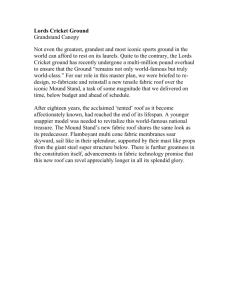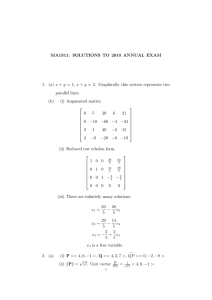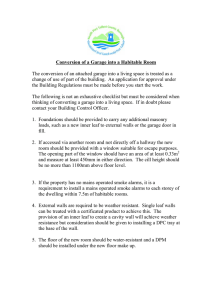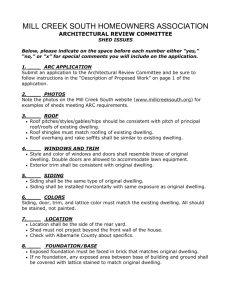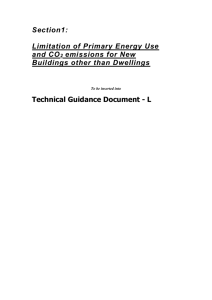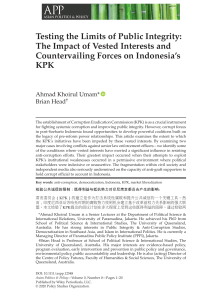Heat loss from a building - Leeds Beckett University
advertisement
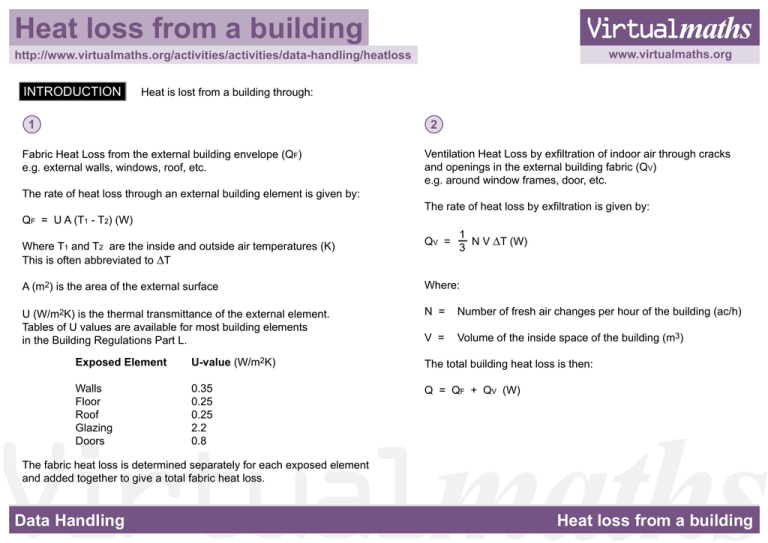
Heat loss from a building www.virtualmaths.org http://www.virtualmaths.org/activities/activities/data-handling/heatloss INTRODUCTION Heat is lost from a building through: 1 2 Fabric Heat Loss from the external building envelope (QF) e.g. external walls, windows, roof, etc. Ventilation Heat Loss by exfiltration of indoor air through cracks and openings in the external building fabric (QV) e.g. around window frames, door, etc. The rate of heat loss through an external building element is given by: The rate of heat loss by exfiltration is given by: QF = U A (T1 - T2) (W) 1 N V ∆T (W) 3 Where T1 and T2 are the inside and outside air temperatures (K) This is often abbreviated to ∆T QV = A (m2) is the area of the external surface Where: U (W/m2K) is the thermal transmittance of the external element. Tables of U values are available for most building elements in the Building Regulations Part L. N = Number of fresh air changes per hour of the building (ac/h) V = Volume of the inside space of the building (m3) Exposed Element U-value (W/m2K) The total building heat loss is then: Walls Floor Roof Glazing Doors 0.35 0.25 0.25 2.2 0.8 Q = QF + QV (W) The fabric heat loss is determined separately for each exposed element and added together to give a total fabric heat loss. Data Handling Heat loss from a building Heat loss from a building www.virtualmaths.org http://www.virtualmaths.org/activities/activities/data-handling/heatloss CALCULATION A flat roofed dwelling measures 8.5m x 12.5m in plan and is 3.2m high. The total external wall area includes 25% area of glazing and has front / back doors with a total area of 4m2 The thermal transmittence (U-values) of the various elements of the building comply with current building regulations and are as follows: Element Walls Floor Roof Glazing Doors U-value (W/m2K) 0.35 0.25 0.25 2.2 0.8 The air infiltration or ventilation rate of the building is 0.5 air changes per hour. The winter internal and external air temperatures are 21oC and -4oC respectively. Calculate the total heat loss for the dwelling in winter conditions. Fabric Heat Loss QF = UA ∆T (W) Element Walls Floor Roof Glazing Doors U (W/m2K) A (m2) ∆T (K) Heat Loss (W) TOTAL Ventilation Heat Loss QV = 1 N V ∆T (W) = 3 (W) (W) U A ∆T N V K W = = = = = = = Thermal transmittance of building element (W/m2K) Surface area of building element (m2) Temperature difference inside to outside (K) Number of fresh air changes per hour Volume of the inside space (m3) Degrees Kelvin Watts Total Dwelling Heat Loss Q = QF + QV = (W) How might the heat loss from the dwelling be reduced to move toward a zero carbon emissions building? Consider the major sources of heat loss from the dwelling. Where might it be possible to reduce these values? Data Handling How might this be achieved? Heat loss from a building
